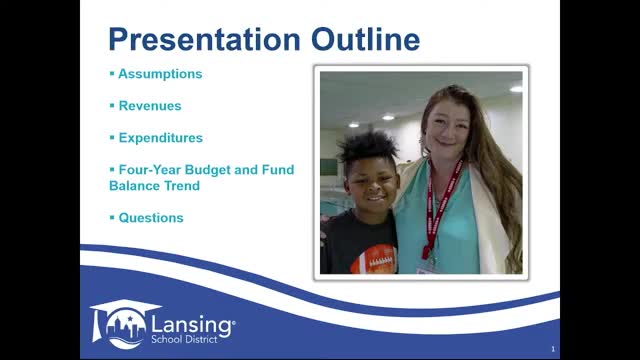School district faces million dollar revenue shortfall
June 14, 2024 | Lansing Public School District, School Boards, Michigan

This article was created by AI summarizing key points discussed. AI makes mistakes, so for full details and context, please refer to the video of the full meeting. Please report any errors so we can fix them. Report an error »

During a recent government meeting, officials presented a comprehensive overview of the district's financial outlook, highlighting key assumptions regarding revenues and expenditures. The discussion included a detailed analysis of the district's four-year budget and fund balance trends, setting the stage for a question-and-answer session.
A significant point raised was the impact of the Headley rollback on property tax revenues. Currently, the district is unable to collect the full 18 mills typically assumed by the state due to this rollback, which limits tax revenue growth to the rate of inflation. As a result, the district is losing approximately $1 million annually in potential revenue. To address this shortfall, officials indicated plans to launch a public campaign aimed at educating the community about the implications of the current tax structure and the need for potential millage rate increases.
The meeting also touched on the district's bonded debt, which stands at $4.1 million, alongside a sinking fund of $2.9575 million. Budget estimates were described as conservative, with officials projecting a foundation allowance of $9,708 per student, based on an anticipated enrollment of 96,100 students—a decrease of 289 students from previous reports.
Revenue sources were outlined, including local property tax levies, miscellaneous revenues from services like facility rentals, and state and federal aid, particularly for special education programs. The officials emphasized the importance of these funding streams in maintaining the district's financial health and supporting educational services.
As the district navigates these financial challenges, the upcoming campaign and budget adjustments will be crucial in addressing the ongoing revenue losses and ensuring adequate funding for future educational needs.
A significant point raised was the impact of the Headley rollback on property tax revenues. Currently, the district is unable to collect the full 18 mills typically assumed by the state due to this rollback, which limits tax revenue growth to the rate of inflation. As a result, the district is losing approximately $1 million annually in potential revenue. To address this shortfall, officials indicated plans to launch a public campaign aimed at educating the community about the implications of the current tax structure and the need for potential millage rate increases.
The meeting also touched on the district's bonded debt, which stands at $4.1 million, alongside a sinking fund of $2.9575 million. Budget estimates were described as conservative, with officials projecting a foundation allowance of $9,708 per student, based on an anticipated enrollment of 96,100 students—a decrease of 289 students from previous reports.
Revenue sources were outlined, including local property tax levies, miscellaneous revenues from services like facility rentals, and state and federal aid, particularly for special education programs. The officials emphasized the importance of these funding streams in maintaining the district's financial health and supporting educational services.
As the district navigates these financial challenges, the upcoming campaign and budget adjustments will be crucial in addressing the ongoing revenue losses and ensuring adequate funding for future educational needs.
View full meeting
This article is based on a recent meeting—watch the full video and explore the complete transcript for deeper insights into the discussion.
View full meeting
